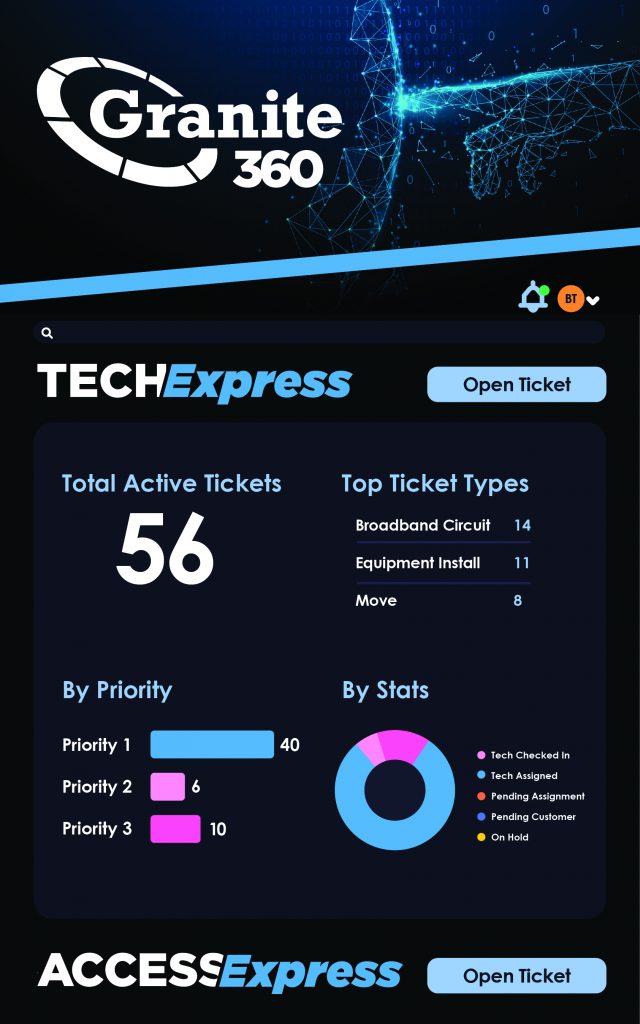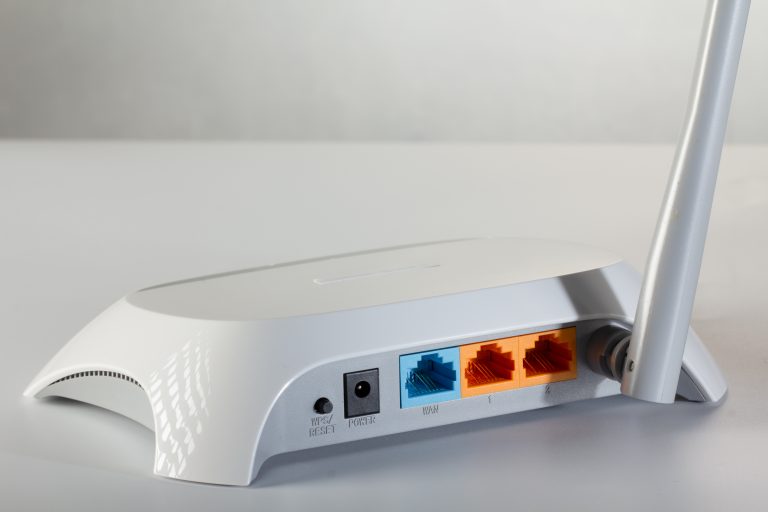
Granite TechExpress
TechExpress customer portal empowers you with granular insights into network performance
Dedicated Ethernet is the ideal solution for businesses that prioritize high-speeds, reliability, and secure internet connectivity. And with speeds of up to 100 Gbps, wide coverage options, and a robust network infrastructure, we provide industry-leading Dedicated Ethernet connectivity to businesses in any location. Granite ensures that businesses can stay connected, productive, and competitive in today’s digital landscape.

Granite’s wireless solution encompasses multi-carrier connectivity, a diverse range of LTE and 5G routers, end-to-end managed services, logistical support, and a robust cloud-based portal for remote oversight, reporting, and troubleshooting. And it operates on a no CapEx model, making it a financially advantageous option for businesses.

Granite, a trusted industry leader, offers a comprehensive infrastructure that spans across multiple locations, providing businesses with exceptional internet connectivity. Moreover, Granite’s On-Net solution incorporates FlexEdge an innovative device powered by Granite Labs.


With Granite, you can say goodbye to the hassle of dealing with multiple vendors and complicated billing processes.
We offer a seamless and streamlined experience, providing you with a 360-degree view of your services across North America and One Bill for your complete business solution.
This consolidated approach saves you time, money, and eliminates the frustration of managing multiple accounts.
Granite knows no bounds. In addition to Service Consolidation, Granite prioritizes Technology Innovation to bring new and unique solutions to our industry.
From unmatched wireline to wireless connectivity options, most trusted WAN and LAN solutions, and the tools and expertise, partnering with Granite puts our customers in the best position to succeed with their business goals.
Ethernet is a networking technology that allows devices within a local area network (LAN) to communicate with each other. It employs a system of protocols, or rules, to handle data transmission between devices.
At its core, Ethernet works by using a combination of electrical signals, known as bits, to transfer data in the form of packets. These packets are then sent over cables, typically using twisted pair or fiber optic cables, from one device to another.
To ensure efficient and reliable data transmission, Ethernet employs several key mechanisms:
1. Ethernet Frames
Data is organized into Ethernet frames which consist of several components, including a preamble, destination and source addresses, and the data payload. These frames have a maximum size defined by the Ethernet standard, which helps prevent data fragmentation and ensures efficient transmission.
2. MAC Addresses
Every Ethernet device has a unique Media Access Control (MAC) address assigned by its manufacturer. MAC addresses play a vital role in routing data within an Ethernet network, allowing devices to identify each other and determine the appropriate destination for the transmitted data.
3. Switching and Routing
Ethernet networks rely on switches and routers to manage and direct data traffic. Switches work at the data link layer and are responsible for forwarding data within a LAN based on the MAC addresses. Routers, on the other hand, operate at the network layer and are used to connect different LANs or networks together.
4. Collision Detection and Avoidance
Ethernet uses a carrier sense multiple access with collision detection (CSMA/CD) protocol to prevent data collisions when multiple devices attempt to transmit data simultaneously. CSMA/CD ensures that only one device is transmitting at any given time, minimizing the chances of data corruption or loss due to collisions.
Please see the below example to explain how an IP block is read:
Example IP Block: 172.85.143.125/30
*Please be aware that if a customer wants anything larger than a /30 block of IPs for any on-net order, they will need to have the IP Justification form filled out and given back to the provisioning rep BEFORE the order completes out*
There are 5 main technologies that Granite offers:
Ethernet over Hybrid Fiber Coax (EoHFC)
Ethernet over Hybrid Fiber Coax (EoHFC) is a networking technology that utilizes coaxial cable for the final mile delivery, allowing cable providers to expand their network coverage. With maximum bandwidth speeds of 20 Mbps, EoHFC enables efficient distribution of television channels from the cable system’s distribution facility, known as the headend, to local communities.
In this system, optical fiber subscriber lines are used to transmit the television signals from the headend to the local community. At the local community, an optical node translates the light beam signal into radio frequency (RF) before sending it over coaxial cable lines to end-user locations. This hybrid fiber-coaxial setup ensures that sufficient bandwidth is available for future expansion and the provisioning of bandwidth-intensive services.
Fast Ethernet (FE)
Fast Ethernet (FE) is an extension of the original 10 megabit Ethernet standard, offering maximum bandwidth of 100 Mbps. It operates on twisted pair or optical fiber cables, following a star wired bus topology. FE supports 100 Base-T handoffs on a FE interface, allowing for seamless connectivity between network devices.
While the standard transmission rate of Fast Ethernet is 100 Mbps, the actual information rate observed on real networks is lower. This is due to the necessary header and trailer components (addressing and error-detection bits) present in every Ethernet frame, as well as the required inter-packet gap between transmissions.
Gigabit Ethernet (GE)
Gigabit Ethernet (GE) is capable of delivering maximum bandwidth speeds of 1000 Mbps or 1 Gbps, making it ten times faster than Fast Ethernet. GE maintains compatibility with existing copper and electrical connections at end user locations, making it a scalable solution for network upgrades from as low as 5 Mbps up to 1 Gbps in various markets.
Similar to Fast Ethernet, the actual information rate achieved on real networks is less than the theoretical maximum due to the necessary header and trailer components and the inter-packet gap between transmissions. Gigabit Ethernet is delivered over the same infrastructure and fiber as Fast Ethernet, utilizing widely available cables and equipment.
10Gigabit Ethernet (10GE)
10 Gigabit Ethernet (10GE) is a high-speed networking technology that allows for the transmission of Ethernet frames at a rate of 10 gigabits per second (Gbps). Unlike previous Ethernet standards, 10GE defines only full-duplex point-to-point links, typically connected by network switches. The shared-medium CSMA/CD operation found in previous Ethernet generations, as well as half-duplex operation and repeater hubs, does not exist in 10GE.
To accommodate different physical layer (PHY) standards, networking devices such as switches or network interface controllers may utilize pluggable PHY modules, including SFP+. 10GE can be implemented using either copper or fiber cabling, with a maximum distance of 100 meters over copper cables. However, higher-grade cables are required due to the bandwidth demands of 10GE.
10GE is commonly used for major infrastructure backhaul and as a replacement for legacy OC-192 circuits in network backbones. The compatibility between 10GE and OC-192 standards facilitates a smooth transition to this high-speed Ethernet technology.
100Gigabit Ethernet (100GE)
Capable of delivering a maximum bandwidth of 100 gigabits per second (Gbps), 100 Gigabit Ethernet (100GE) represents the pinnacle of Ethernet networking speeds. Standardization efforts for 100GE have been underway, with the IEEE P802.3ct Task Force aiming to define the necessary specifications.
The goals for the 100GE standards include full-duplex operation, preservation of the Ethernet frame format utilizing the Ethernet MAC, support for a MAC data rate of 100 Gbps, and ensuring a bit error rate (BER) of better than or equal to 10^-12 at the MAC/PLS service interface. Additionally, the physical layer specification should support 100 Gbps operation on a single wavelength, allowing for a transmission distance of at least 80 km over a dense wavelength-division multiplexing (DWDM) system.
Due to the increased complexity and cost of equipment and optics required to support this advanced technology, the availability of 100GE is currently limited. However, as the industry continues to evolve, advancements in technology may lead to wider adoption and increased accessibility.